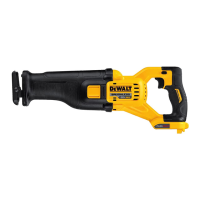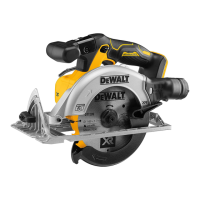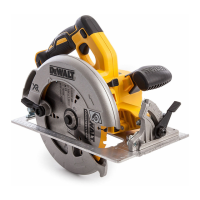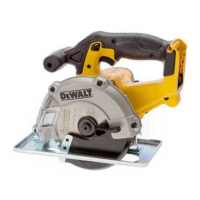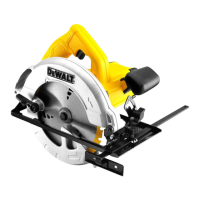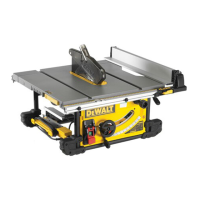6
ENGLISH
Checking and Changing the Saw Blade
• Only use saw blades conforming to the specifications
contained in these operatinginstructions.
• Only sharp saw blades in perfect working condition should
be used; cracked or bent saw blades should be discarded and
replaced atonce.
• Ensure that the saw blade is securelyfixed.
Residual Risks
In spite of the application of the relevant safety regulations
and the implementation of safety devices, certain residual risks
cannot be avoided. These are:
• Impairment ofhearing.
• Risk of personal injury due to flyingparticles.
• Risk of burns due to accessories becoming hot
duringoperation.
• Risk of personal injury due to prolongeduse.
SAVE THESE INSTRUCTIONS
Chargers
DeWALT chargers require no adjustment and are designed to be
as easy as possible tooperate.
Electrical Safety
The electric motor has been designed for one voltage only.
Always check that the battery pack voltage corresponds to the
voltage on the rating plate. Also make sure that the voltage of
your charger corresponds to that of yourmains.
Your DeWALT charger is double insulated in
accordance with IEC60335; therefore no earth wire
isrequired.
If the supply cord is damaged, it must be replaced by a
specially prepared cord available through the DeWALT
serviceorganisation.
Using an Extension Cable
An extension cord should not be used unless absolutely
necessary. Use an approved extension cable suitable for
the power input of your charger (see Technical Data). The
minimum conductor size is 1mm
2
; the maximum length
is30m.
When using a cable reel, always unwind the cablecompletely.
Important Safety Instructions for All Battery
Chargers
SAVE THESE INSTRUCTIONS: This manual contains important
safety and operating instructions for compatible battery
chargers (refer to TechnicalData).
• Before using charger, read all instructions and cautionary
markings on charger, battery pack, and product using
batterypack.
WARNING: Shock hazard. Do not allow any liquid to get
inside charger. Electric shock mayresult.
WARNING: We recommend the use of a residual current
device with a residual current rating of 30mA orless.
improperly or at temperatures outside the specified range
may damage the battery and increase the risk of fire.
6) Service
a ) Have your power tool serviced by a qualified repair
person using only identical replacement parts. This
will ensure that the safety of the power tool is maintained.
b ) Never service damaged battery packs. Service
of battery packs should only be performed by the
manufacturer or authorized service providers.
Additional Safety Instructions for
Reciprocating Saws
• Hold power tool by insulated gripping surfaces when
performing an operation where the cutting accessory
may contact hidden wiring. Cutting accessory contacting
a “live” wire will make exposed metal parts of the power tool
“live” and could give the operator an electricshock.
• Use clamps or another practical way to secure and
support the workpiece to a stable platform. Holding the
work by hand or against your body leaves it unstable and may
lead to loss of control.
• ALWAYS wear a dust mask. Exposure to dust particles can
cause breathing difficulty and possibleinjury.
• Never switch on the tool when the saw blade is jammed in
the workpiece or in contact with thematerial.
• Keep hands away from moving parts. Never place your
hands near the cuttingarea.
• Use extra caution when cutting overhead and pay
particular attention to overhead wires which may be
hidden from view. Anticipate the path of falling branches
and debris ahead oftime.
• Do not operate this tool for long periods of time.
Vibration caused by the operating action of this tool may
cause permanent injury to fingers, hands, and arms. Use
gloves to provide extra cushion, take frequent rest periods, and
limit daily time ofuse.
Switching On and Off
• After switching off, never attempt to stop the saw blade with
yourfingers.
• Never put the saw down on a table or work bench unless
switched off. The saw blade will keep running briefly after the
tool has been switchedoff.
When Sawing
• When using saw blades specially designed for cutting wood
remove all nails and metal objects from the workpiece before
startingwork.
• Wherever possible, use clamps and vices to fasten the
workpiecesecurely.
• Do not attempt to saw extremely smallworkpieces.
• Do not bend too far forward. Make sure that you always stand
firmly, particularly on scaffolding andladders.
• Always hold the saw with bothhands.
• For cutting curves and pockets, use an adapted sawblade.

